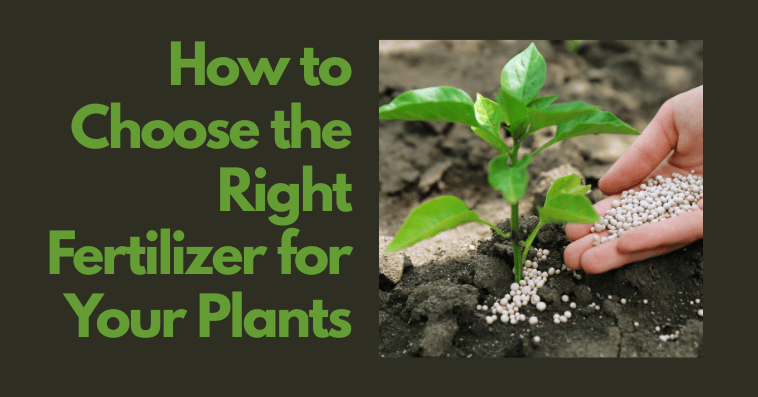Whether you’re growing herbs on a windowsill, vegetables in a backyard, or houseplants in your living room, one thing remains constant — your plants need proper nutrition to thrive. Just like humans need a balanced diet, plants require a steady supply of essential nutrients to stay green, healthy, and productive.
That’s where fertilizers come in. But with so many options out there — organic vs. synthetic, NPK ratios, slow-release vs. liquid — it’s easy to feel overwhelmed.
In this blog, we’ll break it all down so you can confidently choose the right fertilizer for your plants based on their needs, soil type, and growing environment. Whether you're a beginner or a seasoned gardener, this guide will ensure your green friends are always well-fed and flourishing.
Why Do Plants Need Fertilizer?
Plants need more than just water and sunlight. The soil provides nutrients, but over time (especially in pots or raised beds), those nutrients get depleted. Fertilizer acts as a supplement, restoring what’s lost and supporting:
Healthy root development
Lush foliage growth
Strong flowering and fruiting
Disease resistance
Overall plant vigor
Without proper fertilization, even well-watered and sun-kissed plants can look dull or stop growing.
Understanding Plant Nutrients: What’s in a Fertilizer?
The most important nutrients in any fertilizer are called macronutrients, and they include:
N – Nitrogen: Promotes leaf and stem growth
P – Phosphorus: Supports strong roots, flowers, and fruit
K – Potassium: Enhances overall plant health and resistance
This is where NPK values come in—those three numbers on a fertilizer bag (e.g., 10-10-10) represent the percentage of nitrogen, phosphorus, and potassium.
Depending on your plant's purpose, you’ll want to select the appropriate NPK ratio.
🌱 General Guide to NPK Ratios:
High Nitrogen (e.g., 20-10-10) – For leafy greens, lawns, or foliage plants
High Phosphorus (e.g., 10-20-10) – For flowering plants, bulbs, and fruiting vegetables
High Potassium (e.g., 10-10-20) – For overall resilience and late-season crops
Types of Fertilizers: Organic vs. Synthetic
✅ Organic Fertilizers
Made from natural materials like compost, manure, or plant-based substances. They release nutrients slowly and improve soil health over time.
Examples: Vermicompost, cow dung, seaweed extract, bone meal, neem cake
Pros:
Environmentally friendly
Improves soil structure and microbial activity
Low risk of over-fertilization
Best for: Home gardeners, edible plants, long-term soil health
⚠️ Synthetic Fertilizers
These are lab-made fertilizers designed for quick absorption. Commonly used in commercial farming or when fast results are needed.
Examples: Urea, DAP, NPK granules, liquid foliar sprays
Pros:
Quick results
Precise nutrient ratio
Cons:
Can degrade soil quality over time
Risk of chemical buildup and root burn
Best for: Controlled environments, short-term fixes
How to Choose the Right Fertilizer Based on Plant Type
Not all plants have the same nutrient needs. Here’s a breakdown:
🪴 Foliage Plants (e.g., money plant, ferns, rubber plant)
Need: More nitrogen
Best Fertilizer: Balanced or high-nitrogen organic fertilizer
🌸 Flowering Plants (e.g., roses, hibiscus, marigold)
Need: Phosphorus for blooming
Best Fertilizer: Phosphorus-rich organic mix or bone meal
🍅 Vegetables and Fruits (e.g., tomatoes, chillies, okra, lemons)
Need: Balanced nutrition with extra potassium during fruiting
Best Fertilizer: Vermicompost, seaweed extract, potash-rich organic blends
🌿 Herbs (e.g., mint, basil, coriander)
Need: Light feeding; too much nitrogen affects flavor
Best Fertilizer: Compost tea or mild organic compost
🌱 Seedlings and Saplings
Need: Gentle nutrients to support root growth
Best Fertilizer: Diluted compost extract, fish emulsion, or worm tea
Choosing the Right Fertilizer Format
Fertilizers come in various forms. Choose what works best for your gardening style:
1. Granular Fertilizers
Easy to store and apply
Long-lasting, slow-release
Great for garden beds and potted plants
2. Liquid Fertilizers
Quick absorption
Ideal for foliar feeding
Best for a fast nutrient boost
3. Compost and Manure
Improves soil over time
Ideal for all plant types
Should be well-rotted before use
4. Spikes and Tablets
Easy to use
Perfect for indoor potted plants
Slow-release and mess-free
How Often Should You Fertilize?
Over-fertilization is just as harmful as neglect. Here’s a general guide:
Indoor plants: Once every 4–6 weeks (less during winters)
Outdoor potted plants: Every 2–4 weeks during growing season
Vegetables/fruits: Every 10–15 days (adjust based on plant response)
Lawns and flowering beds: Monthly during peak season
Always water your plants before and after fertilizing to prevent root burn and help nutrient absorption.
Additional Tips to Get the Best Results
Test your soil occasionally to know its current nutrient status
Observe your plant—yellow leaves, slow growth, or no blooms may indicate deficiency
Use mulch or compost alongside fertilizers to retain moisture and improve soil
Choose fertilizers with added micronutrients like calcium, magnesium, and sulfur
Rotate between types (e.g., liquid and compost) to avoid buildup
Where to Buy the Best Fertilizer for Your Plants?
Looking for affordable, high-quality organic fertilizers that are safe and effective?
Shop from PaudheWale – your one-stop destination for all things gardening.
At PaudheWale, you can find:
✅ Organic compost, cow dung, and vermicompost
✅ Ready-to-use NPK fertilizer blends
✅ Liquid foliar sprays for flowering and fruiting
✅ Fertilizer packs specially curated for houseplants, herbs, and vegetables
All products are 100% safe for home use, eco-friendly, and delivered right to your doorstep.

